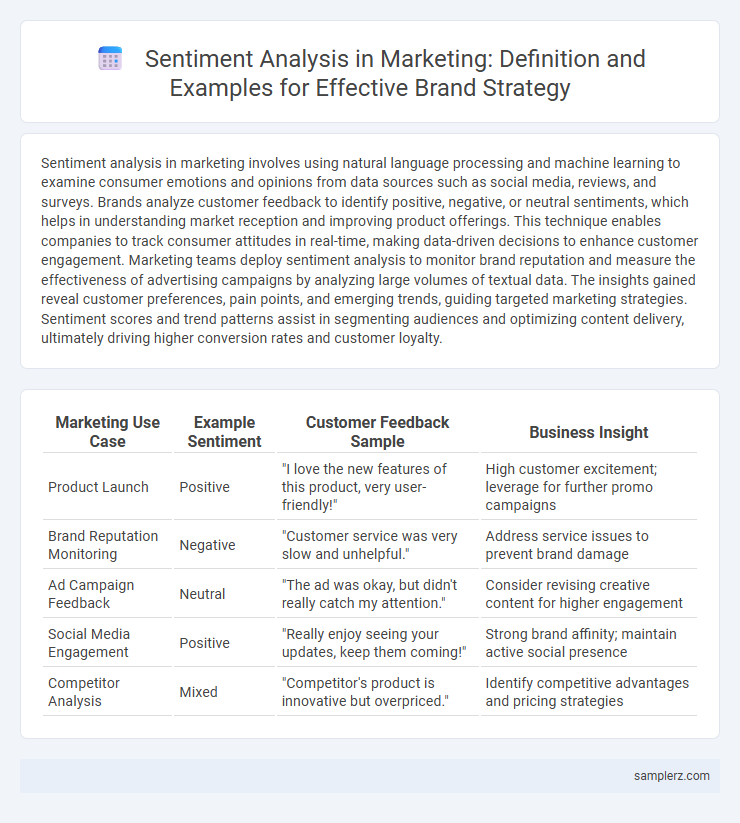Sentiment analysis in marketing involves using natural language processing and machine learning to examine consumer emotions and opinions from data sources such as social media, reviews, and surveys. Brands analyze customer feedback to identify positive, negative, or neutral sentiments, which helps in understanding market reception and improving product offerings. This technique enables companies to track consumer attitudes in real-time, making data-driven decisions to enhance customer engagement. Marketing teams deploy sentiment analysis to monitor brand reputation and measure the effectiveness of advertising campaigns by analyzing large volumes of textual data. The insights gained reveal customer preferences, pain points, and emerging trends, guiding targeted marketing strategies. Sentiment scores and trend patterns assist in segmenting audiences and optimizing content delivery, ultimately driving higher conversion rates and customer loyalty.
Table of Comparison
| Marketing Use Case | Example Sentiment | Customer Feedback Sample | Business Insight |
|---|---|---|---|
| Product Launch | Positive | "I love the new features of this product, very user-friendly!" | High customer excitement; leverage for further promo campaigns |
| Brand Reputation Monitoring | Negative | "Customer service was very slow and unhelpful." | Address service issues to prevent brand damage |
| Ad Campaign Feedback | Neutral | "The ad was okay, but didn't really catch my attention." | Consider revising creative content for higher engagement |
| Social Media Engagement | Positive | "Really enjoy seeing your updates, keep them coming!" | Strong brand affinity; maintain active social presence |
| Competitor Analysis | Mixed | "Competitor's product is innovative but overpriced." | Identify competitive advantages and pricing strategies |
Real-Time Customer Feedback Analysis in Marketing
Real-time customer feedback analysis in marketing leverages sentiment analysis to instantly gauge consumer emotions from social media comments, reviews, and live chat interactions. Brands use this data to quickly adjust campaigns, improve customer service, and enhance product offerings based on current customer sentiment trends. Tools like Brandwatch and Sprout Social provide marketers with actionable insights by tracking positive, negative, and neutral sentiments in real time.
Enhancing Product Launches with Sentiment Tracking
Sentiment analysis enables marketers to gauge real-time consumer reactions during product launches, providing actionable insights for immediate adjustments to messaging and positioning. By analyzing social media comments, reviews, and surveys, brands can identify positive or negative sentiments, optimizing marketing strategies to enhance customer engagement and boost launch success. This data-driven approach reduces risk and maximizes impact by aligning campaigns with audience emotions and expectations.
Measuring Brand Reputation Through Social Sentiment
Measuring brand reputation through social sentiment involves analyzing customer opinions and emotions expressed on social media platforms, review sites, and forums using advanced natural language processing tools. This process enables marketers to gauge public perception, identify potential crises early, and tailor campaigns to improve customer engagement and loyalty. By quantifying positive, neutral, and negative sentiments, brands can strategically enhance their market positioning and drive more effective marketing decisions.
Optimizing Ad Campaigns Based on Consumer Emotions
Sentiment analysis enables marketers to evaluate consumer emotions gathered from social media, reviews, and feedback, allowing precise targeting in ad campaigns. By identifying positive or negative sentiments toward specific products or messaging, brands can tailor their advertisements to resonate deeply with audience preferences, increasing engagement and conversion rates. This data-driven approach optimizes budget allocation by focusing on ads that evoke favorable emotional responses, enhancing overall campaign effectiveness and ROI.
Leveraging Sentiment Analysis for Influencer Marketing
Leveraging sentiment analysis in influencer marketing enhances brand-customer relationships by identifying positive or negative emotions in social media content and audience feedback. Brands use sentiment analysis tools to assess influencers' audience reactions, optimizing partnerships with those generating favorable sentiments to boost campaign effectiveness and brand reputation. This data-driven approach enables targeted influencer selection and content adjustments, maximizing engagement and return on investment (ROI).
Competitor Analysis Using Sentiment Data
Sentiment analysis in marketing enables brands to gauge consumer emotions toward competitors by analyzing social media comments, reviews, and forums. By extracting positive, negative, and neutral sentiments, companies can identify competitors' strengths and weaknesses, improving strategic positioning. Leveraging sentiment data allows marketers to tailor campaigns, enhance product features, and address gaps that competitors may have overlooked.
Improving Customer Service with Sentiment Insights
Sentiment analysis in marketing enhances customer service by identifying emotions in customer feedback across social media, reviews, and support tickets. Brands like Amazon use sentiment insights to detect frustration or satisfaction in real-time, enabling faster resolution and personalized responses. This data-driven approach increases customer loyalty and optimizes support strategies, resulting in higher retention rates and improved brand reputation.
Personalizing Marketing Messages with Emotional Data
Sentiment analysis in marketing enables brands to personalize marketing messages by analyzing customer emotions expressed in social media posts and reviews. By identifying positive, negative, or neutral sentiments, companies tailor content that resonates emotionally with target audiences, boosting engagement and conversion rates. Emotional data-driven personalization enhances customer experience, fostering brand loyalty and increasing ROI.
Crisis Management in Marketing Using Sentiment Trends
Sentiment analysis in marketing plays a crucial role in crisis management by monitoring real-time consumer emotions and identifying negative sentiment spikes on social media platforms like Twitter and Facebook. Brands use AI-driven sentiment trend analysis to detect emerging crises early, enabling swift response strategies that mitigate reputational damage and maintain customer trust. Tools such as Brandwatch and Lexalytics provide granular insights into sentiment shifts, empowering marketing teams to adjust messaging and communication during crises effectively.
Case Studies: Successful Sentiment Analysis in Marketing
Coca-Cola leveraged sentiment analysis to monitor customer reactions during their "Share a Coke" campaign, leading to personalized marketing strategies that boosted sales by 7%. Amazon used sentiment analysis on product reviews to refine recommendations and enhance customer experience, resulting in increased user engagement. Starbucks analyzed social media sentiment to identify trending preferences, informing new product development and regional promotions that improved market share.

example of sentiment analysis in marketing Infographic
 samplerz.com
samplerz.com